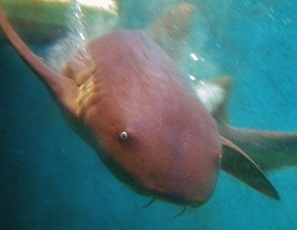
Fred and Barney
These two nurse sharks reside in Gulf Shore Aquarium's Florida Fishes tank with black drum, striped mullet, mangrove snapper and other smaller fish. "The boys," as they're affectionately known, started out as personal pets, but their owner donated them to GSA when they grew too large for him to keep at his home.
In the wild, nurse sharks live near the sea floor in the warm, shallow waters of the western Atlantic and eastern Pacific oceans.
Nurse sharks average seven to nine feet long, but the males can grow up to 14 feet. Fred and Barney might live to be 25 years old in human care.
They're usually harmless to people. But they have thousands of tiny, serrated teeth and will bite if stepped on or harassed. Fred and Barney usually ignore divers who enter their tank, but there was that "close call" with photographer Evan Sanders that one time. Education specialist Danielle "Dani" Davidson was a witness, as were a group of guests watching the shark feeding.
In the wild, nurse sharks sleep during the day and hunt at night, prowling along the bottom and using their powerful suction ability to dislodge prey hiding in the sand and among the rocks. They can even suck a sea snail from its shell. At Gulf Shore, Fred and Barney eat squid and a forage fish called capelin, which is a member of the smelt family and is found in the Atlantic and Arctic oceans.
Unlike most other sharks, nurse sharks are smooth to the touch. And they don't have to be moving to breathe. Nurse sharks (and some others) breathe through a method called buccal pumping, which was typical of ancient sharks. Muscles around their mouths pull water in, sending it over their gill membranes and out their gill slits. The fish absorbs oxygen from the water as it passes by.
Nurse sharks often rest on the bottom during the day in groups of up to 40, sometimes piled on top of each other. Fred and Barney often can be found lying side by side on the floor of their tank.
Like other sharks, the boys have a skeleton made of cartilage and are related to rays and skates.
Nurse sharks may get their name from the sucking sound (kind of like a nursing baby) they make when hunting. Or it may come from the word “nusse,” meaning cat shark. But most likely it comes from the Old English word “hurse,” which means sea-floor shark.
Material from nationalgeographic.com and discovery.com was used in this report.
These two nurse sharks reside in Gulf Shore Aquarium's Florida Fishes tank with black drum, striped mullet, mangrove snapper and other smaller fish. "The boys," as they're affectionately known, started out as personal pets, but their owner donated them to GSA when they grew too large for him to keep at his home.
In the wild, nurse sharks live near the sea floor in the warm, shallow waters of the western Atlantic and eastern Pacific oceans.
Nurse sharks average seven to nine feet long, but the males can grow up to 14 feet. Fred and Barney might live to be 25 years old in human care.
They're usually harmless to people. But they have thousands of tiny, serrated teeth and will bite if stepped on or harassed. Fred and Barney usually ignore divers who enter their tank, but there was that "close call" with photographer Evan Sanders that one time. Education specialist Danielle "Dani" Davidson was a witness, as were a group of guests watching the shark feeding.
In the wild, nurse sharks sleep during the day and hunt at night, prowling along the bottom and using their powerful suction ability to dislodge prey hiding in the sand and among the rocks. They can even suck a sea snail from its shell. At Gulf Shore, Fred and Barney eat squid and a forage fish called capelin, which is a member of the smelt family and is found in the Atlantic and Arctic oceans.
Unlike most other sharks, nurse sharks are smooth to the touch. And they don't have to be moving to breathe. Nurse sharks (and some others) breathe through a method called buccal pumping, which was typical of ancient sharks. Muscles around their mouths pull water in, sending it over their gill membranes and out their gill slits. The fish absorbs oxygen from the water as it passes by.
Nurse sharks often rest on the bottom during the day in groups of up to 40, sometimes piled on top of each other. Fred and Barney often can be found lying side by side on the floor of their tank.
Like other sharks, the boys have a skeleton made of cartilage and are related to rays and skates.
Nurse sharks may get their name from the sucking sound (kind of like a nursing baby) they make when hunting. Or it may come from the word “nusse,” meaning cat shark. But most likely it comes from the Old English word “hurse,” which means sea-floor shark.
Material from nationalgeographic.com and discovery.com was used in this report.
